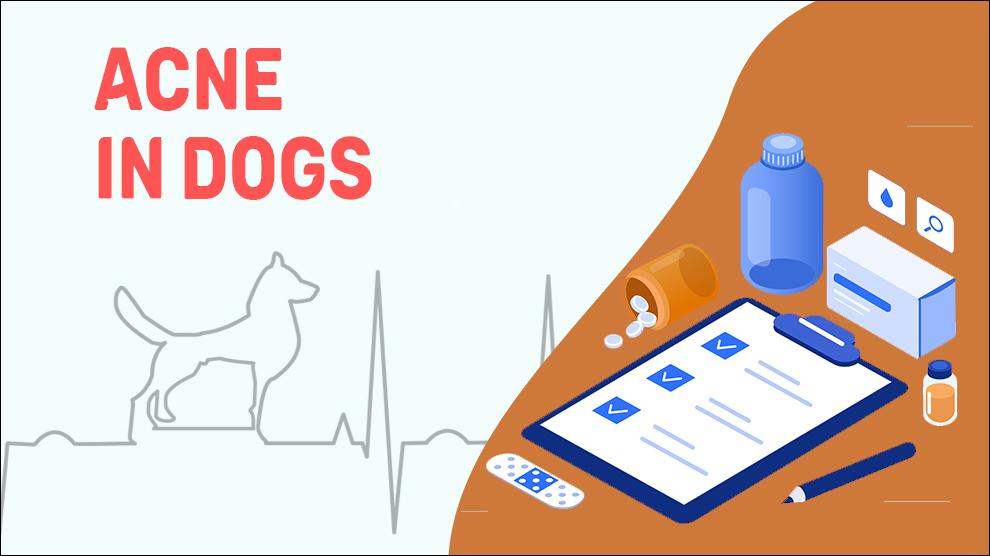What Is An Acne In Dogs?
Similar to acne in humans, dogs can also get acne. Dog acne, zits, pimples, plukes, spots etc., call them what you like, but acnes are also definitely a canine thing.
Usually they get it when they go through puberty, but is it the same kind of acne that human beings worried over? Canine acne is also referred to as furunculosis or folliculitis. Much like humans, there are other reasons such as allergies, infection, and stress that play a heavy hand in dog acne.
Symptoms Of Acne In Dogs
Initial signs may include:
- Erythema (redness)
- Comedones
- Hairless papules
- Nodules
- Pustules
- Furuncles
- Cellulitis with plaques
- Swelling
- Bleeding
- Pruritus (Itchiness)
Progressive or later signs can include:
- Pus discharge(Suppurative), furunculosis and/or folliculitis
- Ulcerated lesions with or without discharge
- Large papules
- Scars from lesions that have healed
- Extremely inflamed/irritated
Treatment Options For Acne In Dogs
Although it may be tempting to squeeze, prod, or pop at bumps, it’s a bad idea and could exacerbate the issue. Picking the spots could make the problem worse and cause the acne to spread or even cause a more serious infection. The most that you can do is apply warm compresses - to reduce swelling and inflammation. The rest should be left to a professional opinion.
The treatment protocol for canine acne consists of several types of medications that can help remove the excess sebum, control the inflammation and thwart any secondary bacterial infection. These include:
- Topical application of Benzoyl peroxide to help flush out the hair follicles and minimize bacterial contamination
- Steroids can decrease the swelling and inflammation within the skin. Oral steroids (Prednisone or prednisolone ) and topical steroids(betamethasone or fluocinolone)
- Oral broad-spectrum antibiotics are usually required to decrease the bacterial population and treat infected lesions. Topical antibiotic creams and gels are of limited value as puppies licks it off as soon as it is applied
Home Remedies For Acne In Dogs
If trauma or allergy is the cause of your dog’s acne, take steps to decrease or avoid the problem.
Wash out those dirty hair follicles (follicle flushing) using medicated shampoos.
Apple Cider Vinegar (ACV) or Green Tea or Aloe Vera or nettle can be applied.
A chlorhexidine antimicrobial solution (1:10 dilution) can be applied to the area. After five minutes contact time, rinse off with plain water. It can be used until the breakout subsides.
Keep your pet’s facial fold and muzzle clean and dry using hypoallergenic wipes or a clean towel.
Prevention Of Acne In Dogs
Usually, dog acne will clear up on itself as your dog grows up, so there’s usually no reason to worry. However, there are still certain preventative measures you can take to keep it at bay.
The best way to prevent is maintaining a proper hygiene with products engineered specifically for dogs and keeping your dog’s muzzle clean by giving quick wipes after meal times.
For Dogs having a wrinkled, loose skin folds such as a Boxer or Bulldog, make sure to delve deep in the skinny wrinkles to unclog any dirt, debris and other irritants.
Do not allow your puppy to rub their face on toys, carpets, and rugs that have any sharp edges, which could scrape the skin that might cause trauma.
Vets also might recommend changing your pet’s bowls to nonporous, smooth bowls made from ceramic, stainless steel or porcelain and cleaning them daily.
Affected Dog Breeds Of Acne
Boxer, English Bulldog, Great Dane, German Shorthaired Pointer, Weimaraner, Mastiff, Rottweiler, Doberman Pinscher, Pug.
Young dogs are much more likely to get canine acne than adult or senior dogs. Breeds that have short bristly muzzle fur and extra skin folds are at higher risk.
Additional Facts For Acne In Dogs
Canine acne is a benign, self-limiting, inflammatory disorder of the muzzle and lips. Puppies (5-8 months old) are much more likely to get canine acne than grown up dogs. The conditions are mild and will go away on their own once they get older.
Some of the most common breeds to get acne are those who have extra skin folds and short bristly muzzle fur, such as bulldogs, rottweilers, boxers etc. Dirt and bacteria accumulates in the crevices and folds of their skin easily and excess oily sebum mix together with the dead cells causing hair follilces to get clogged resulting in whiteheads or blackheads.
As with humans, hormones, distress and genetics may play a major role in why some dogs develop a “pizza face”.
Some dogs also get zits on the tummy, but this is usually labeled not as acne but more as a spotty tummy.
When To See A Vet For Acne In Dogs?
If the acne seems to be getting flared up or if there seems to be an infection or progressively getting worse, you should take your dog to the vet.
Skin lesions containing pus.
Fat faced with swelling in skin of the lips and muzzle.
Burst pustules with bleeding wounds.
Food Suggestions For Acne In Dogs
Conclusion
Proper hygiene makes a big difference, but still, your dog’s genes play the spoilsport. No outright cure exists for acne but canine acne subsides on its own.
Rule number one in acne treatment (applicable to humans as well) is obvious yet often difficult to follow: Do not pop, prick or poke your dog’s pimples.
Consulting a veterinarian is important. Never assume it’s just an acne, because the problem can be sometimes complex.

















